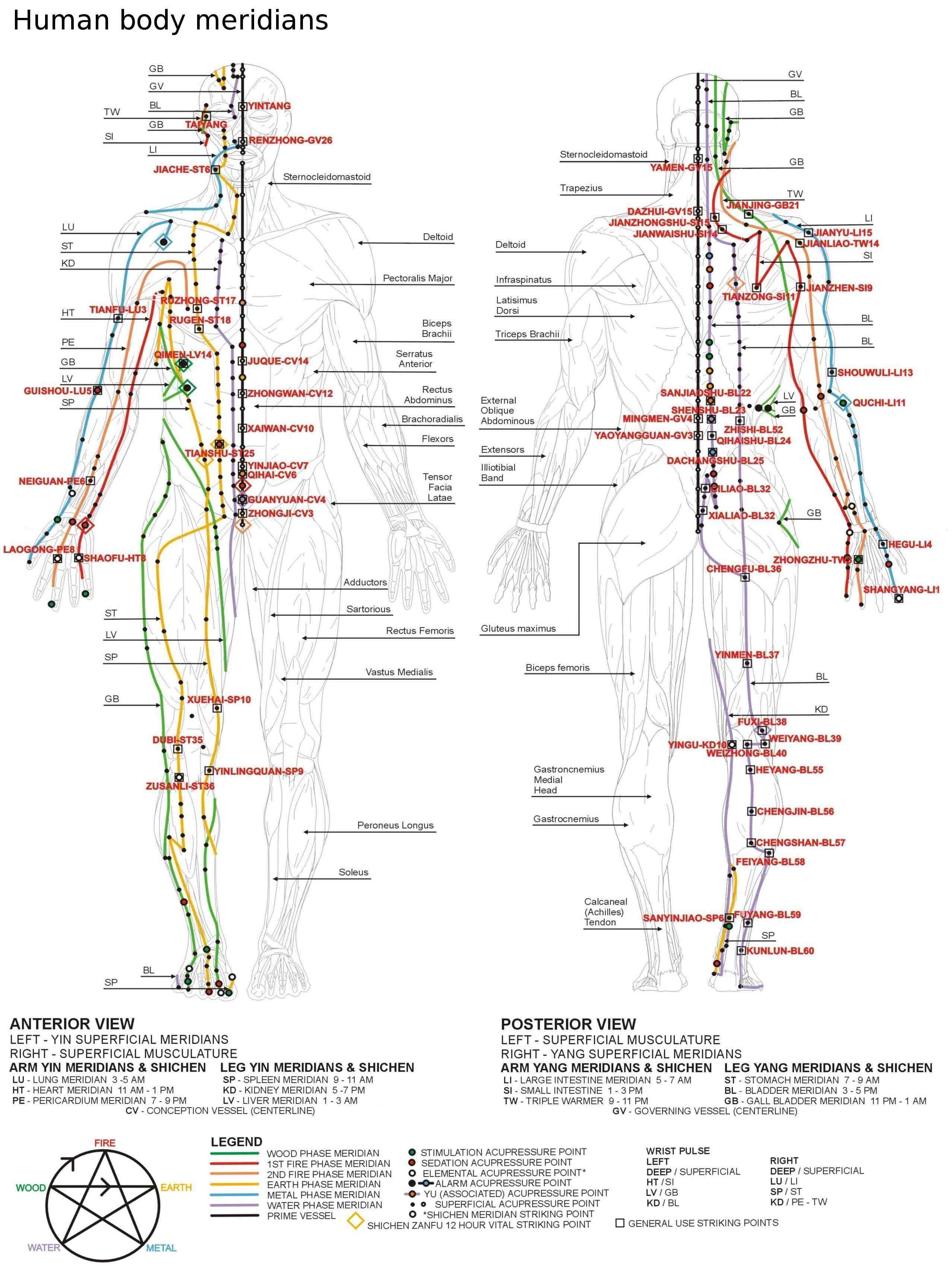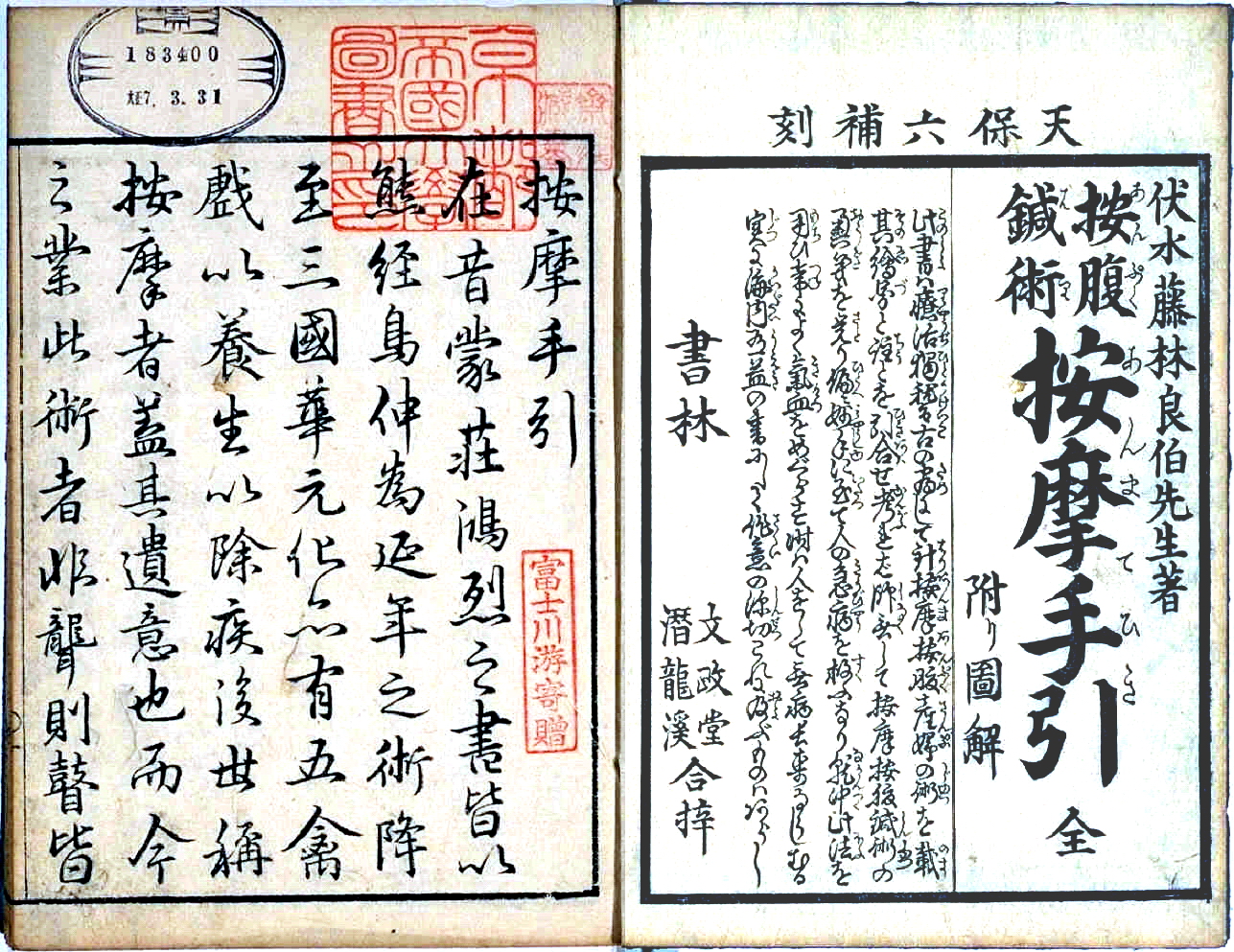Shiatsu Massage on:
[Wikipedia]
[Google]
[Amazon]
''Shiatsu'' ( ; ) is a form of Japanese bodywork based on concepts in traditional Chinese medicine such as qi meridians. Having been popularized in the twentieth century by
 ''Shiatsu'' evolved from '' anma'', a Japanese style of massage developed in 1320 by Akashi Kan Ichi. Anma was popularised in the seventeenth century by acupuncturist Sugiyama Waichi, and around the same time the first books on the subject, including Fujibayashi Ryohaku's ''Anma Tebiki'' ("Manual of Anma"), appeared.
''Shiatsu'' evolved from '' anma'', a Japanese style of massage developed in 1320 by Akashi Kan Ichi. Anma was popularised in the seventeenth century by acupuncturist Sugiyama Waichi, and around the same time the first books on the subject, including Fujibayashi Ryohaku's ''Anma Tebiki'' ("Manual of Anma"), appeared.
 The Fujibayashi school carried anma into the modern age. Prior to the emergence of ''shiatsu'' in
The Fujibayashi school carried anma into the modern age. Prior to the emergence of ''shiatsu'' in
European Shiatsu Federation
{{Authority control Acupuncture Alternative medicine
Tokujiro Namikoshi
is the founder of Shiatsu therapy. p. 193.
Biography
At the age of seven, he discovered His manual therapy pressure method while treating his mother's rheumatoid arthritis
Rheumatoid arthritis (RA) is a long-term autoimmune disorder that p ...
(1905–2000), ''shiatsu'' derives from the older Japanese massage modality called '' anma''.
There is no scientific evidence
Evidence for a proposition is what supports this proposition. It is usually understood as an indication that the supported proposition is true. What role evidence plays and how it is conceived varies from field to field.
In epistemology, evidenc ...
that ''shiatsu'' will prevent or cure any disease. Although it is considered a generally safe treatment—if sometimes painful—there have been reports of adverse health effects arising from its use, a few of them serious.
Description
In the Japanese language, ''shiatsu'' means "finger pressure". ''Shiatsu'' techniques include massages with fingers, thumbs, elbow, knuckle, feet and palms; acupressure, assisted stretching; and joint manipulation and mobilization. To examine a patient, a shiatsu practitioner uses palpation and, sometimes, pulse diagnosis. The Japanese Ministry of Health defines ''shiatsu'' as "a form of manipulation by thumbs, fingers and palms without the use of instruments, mechanical or otherwise, to apply pressure to the human skin to correct internal malfunctions, promote and maintain health, and treat specific diseases. The techniques used in ''shiatsu'' include stretching, holding, and most commonly, leaning body weight into various points along key channels." The practice of ''shiatsu'' is based on the traditional Chinese concept of '' qi'', which is sometimes described as an "energy flow". ''Qi'' is supposedly channeled through certain pathways in the human body, known as meridians, causing a variety of effects. Despite the fact that many practitioners use these ideas in explaining ''shiatsu'', neither ''qi'' nor meridians exist as observable phenomena.Efficacy
There is no evidence that ''shiatsu'' is of any benefit in treating cancer or any other disease, though some evidence suggests it might help people feel more relaxed. In 2015, the Australian Government's Department of Health published the results of a review of alternative therapies that sought to determine if any were suitable for being covered byhealth insurance
Health insurance or medical insurance (also known as medical aid in South Africa) is a type of insurance that covers the whole or a part of the risk of a person incurring medical expenses. As with other types of insurance, risk is shared among ma ...
; ''shiatsu'' was one of 17 therapies evaluated for which no clear evidence of effectiveness was found. Accordingly, in 2017, the Australian government named ''shiatsu'' as a practice that would not qualify for insurance subsidy, to ensure the best use of insurance funds.
''Shiatsus claims of having a positive impact on a recipient's sense of vitality and well-being have to some extent been supported by studies where recipients reported improved relaxation, sleep, and lessened symptom severity. However, the state of the evidence on its efficacy for treating any malady is poor, and one recent systematic review
A systematic review is a Literature review, scholarly synthesis of the evidence on a clearly presented topic using critical methods to identify, define and assess research on the topic. A systematic review extracts and interprets data from publ ...
did not find ''shiatsu'' to be effective for any particular health condition. It is generally considered safe, though some studies have reported negative effects after a treatment with ''shiatsu'', and examples of serious health complications exist including one case of thrombosis, one embolism, and a documented injury from a "shiatsu-type massaging machine".
History
 The Fujibayashi school carried anma into the modern age. Prior to the emergence of ''shiatsu'' in
The Fujibayashi school carried anma into the modern age. Prior to the emergence of ''shiatsu'' in Japan
Japan ( ja, 日本, or , and formally , ''Nihonkoku'') is an island country in East Asia. It is situated in the northwest Pacific Ocean, and is bordered on the west by the Sea of Japan, while extending from the Sea of Okhotsk in the north ...
, masseurs were often nomadic, earning their keep in mobile massage capacities, and paying commissions to their referrers.
Since Sugiyama's time, massage in Japan had been strongly associated with the blind. Sugiyama, blind himself, established a number of medical schools for the blind which taught this practice. During the Tokugawa period, edicts were passed which made the practice of anma solely the preserve of the blind – sighted people were prohibited from practicing the art. As a result, the "blind anma" has become a popular trope in Japanese culture. This has continued into the modern era, with a large proportion of the Japanese blind community continuing to work in the profession.
Abdominal palpation as a Japanese diagnostic technique was developed by Shinsai Ota in the 17th century.
During the Occupation of Japan
Japan was occupied and administered by the victorious Allies of World War II from the 1945 surrender of the Empire of Japan at the end of the war until the
Treaty of San Francisco took effect in 1952. The occupation, led by the United States wi ...
by the Allies after World War II, traditional medicine practices were banned (along with other aspects of traditional Japanese culture) by General MacArthur. The ban prevented a large proportion of Japan's blind community from earning a living. Many Japanese entreated for this ban to be rescinded. Additionally, writer and advocate for blind rights Helen Keller, on being made aware of the prohibition, interceded with the United States government; at her urging, the ban was rescinded.
Tokujiro Namikoshi
is the founder of Shiatsu therapy. p. 193.
Biography
At the age of seven, he discovered His manual therapy pressure method while treating his mother's rheumatoid arthritis
Rheumatoid arthritis (RA) is a long-term autoimmune disorder that p ...
(1905–2000) founded his ''shiatsu'' college in the 1940s and his legacy was the state recognition of ''shiatsu'' as an independent method of treatment in Japan. He is often credited with inventing modern ''shiatsu''. However, the term ''shiatsu'' was already in use in 1919, when a book called ''Shiatsu Ho'' ("finger pressure method") was published by Tamai Tempaku. Also prior to Namikoshi's system, in 1925 the Shiatsu Therapists Association was founded, with the purpose of distancing ''shiatsu'' from ''anma'' massage.
Namikoshi's school taught ''shiatsu'' within a framework of western medical science. A student and teacher of Namikoshi's school, Shizuto Masunaga
was a Japanese Shiatsu practitioner and author of books on Shiatsu.
He was born in June 1925 in Kure, Hiroshima and graduated in psychology from Kyoto University in 1949. In 1959, he graduated from thJapan Shiatsu Collegeand went on to teach psy ...
, brought to ''shiatsu'' a traditional eastern medicine and philosophic framework. Masunaga grew up in a family of ''shiatsu'' practitioners, with his mother having studied with Tamai Tempaku. He founded Zen Shiatsu and the Iokai Shiatsu Center school. Another student of Namikoshi, Hiroshi Nozaki
Hiroshi Nozaki (1926-2006) was a Shiatsu master and alternative healer well known in Switzerland, France and Italy for his innovative techniques of Shiatsu, Qigong and Yoga and for starting thKo School of Shiatsu(School of Lightness in Japanese La ...
founded the Hiron Shiatsu, a holistic technique of ''shiatsu'' that uses intuitive techniques and a spiritual approach to healing which identifies ways how to take responsibility for a healthy and happy life in the practitioner's own hands. It is practiced mainly in Switzerland, France and Italy, where its founder opened several schools.
See also
* Acupressure *Alternative cancer treatments
Alternative cancer treatment describes any cancer treatment or practice that is not part of the conventional standard of cancer care. These include special diets and exercises, chemicals, herbs, devices, and manual procedures. Most alternative ...
* Jin Shin Do
* Johrei
* Kampo
* Kappo
* Kiyoshi Ikenaga
is a Shiatsu Master, Shiatsupractor (SPR), Chairperson and CEO of thCanadian College of Shiatsu Therapy Founder/Director of thCanadian Shiatsu Society of BC Director of the Canada Branch of the Japan Shiatsu Association, Registered Instructor o ...
* Macrobiotic diet
* Massage chair
* Onsen
In Japan, are the country's hot springs and the bathing facilities and traditional inns around them. As a volcanically active country, Japan has many onsens scattered throughout all of its major islands. There are approximately 25,000 hot ...
* Reflexology
* Reiki
References
External links
European Shiatsu Federation
{{Authority control Acupuncture Alternative medicine